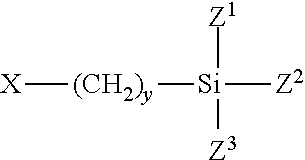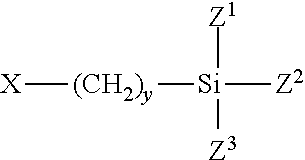Container Sealant Composition
a technology for container sealants and compositions, applied in the direction of film/foil adhesives, packaging, adhesives, etc., can solve the problems of organosilane being useful and suggesting that organosilanes would be useful with respect to carboxylated rubbers or with respect to container sealant compositions
- Summary
- Abstract
- Description
- Claims
- Application Information
AI Technical Summary
Benefits of technology
Problems solved by technology
Method used
Image
Examples
example 1
[0016]This example demonstrates the improvements resulting from the container sealant compositions of the present invention. The organosilane (when present) is added slowly, while stirring, into kaolin clay dispersed CSBR latex in the amounts shown in Table 1, then these mixtures are stirred for 15 to 20 minutes at 200 to 300 rpm. The remaining ingredients are added to this dispersion, which is stirred for one hour then defoamed under vacuum. The results are shown in Table 1.
TABLE 1Amount (parts by weight)ABCDE4IngredientOrganosilane11.801.800CSBR (solid)2100100100100SBR (solid)100Kaolin Clay3030303030.3Stabilizer3001.21.21.2Other ingredients (incl. tackifier)3939393989Hot water absorption of dried filmImmersion for 1 minute (%)1.13.06.510.316.6Immersion for 3 minutes (%)2.75.37.518.130.0Can pack test resultsNumber of cans with leakage after0851115impact (n = 100)1N-(2-aminoethyl)-3-aminopropyltrimethoxysilane (KBM603; ShinEtsu)2XQ 83286.01 (50% CSBR solids; Siam Synthetic Co., Ltd)...
example 2
[0018]A container sealant composition is prepared having the ingredients listed below.
IngredientDry Weight (PHR)CSBR 1100Aluminum-silicate (Kaolin clay)230Amino-organosilane31.8Titanium dioxide5Tackifier430Thickener52.16Carbon black0.3Dispersant60.34Antioxidant711 XQ 83286.01 (50% CSBR solids; Siam Synthetic Co., Ltd)2Buca Clay filler (BASF Catalyst)3N-(2-aminoethyl)-3-aminopropyltrimethoxysilane (KBM603; ShinEtsu)4Blend of Aqueous Dispersion of Polymerized Rosin Ester (10 phr Foralaxe from Eastman Chemical), Hydrogenated Ester Rosin (20 phr Forelyn 5020-F from Eastman Chemical)5Methyl cellulose (1.76) and Karaya gum (0.4)6Naphthalene sulfonic acid, formaldehyde, Na (0.1) and Sodium Carbonate (0.24)7Tetrakis methylene ditertbutylhydroxycinnamate methyl
[0019]The amino-organosilane is added slowly, while stirring, into clay dispersed CSBR latex, then these mixtures are stirred for 15 to 20 minutes at 200 to 300 rpm. The remaining ingredients are added to this dispersion, which is stir...
PUM
| Property | Measurement | Unit |
|---|---|---|
| Percent by mass | aaaaa | aaaaa |
| Percent by mass | aaaaa | aaaaa |
| Weight | aaaaa | aaaaa |
Abstract
Description
Claims
Application Information
 Login to View More
Login to View More - R&D
- Intellectual Property
- Life Sciences
- Materials
- Tech Scout
- Unparalleled Data Quality
- Higher Quality Content
- 60% Fewer Hallucinations
Browse by: Latest US Patents, China's latest patents, Technical Efficacy Thesaurus, Application Domain, Technology Topic, Popular Technical Reports.
© 2025 PatSnap. All rights reserved.Legal|Privacy policy|Modern Slavery Act Transparency Statement|Sitemap|About US| Contact US: help@patsnap.com


